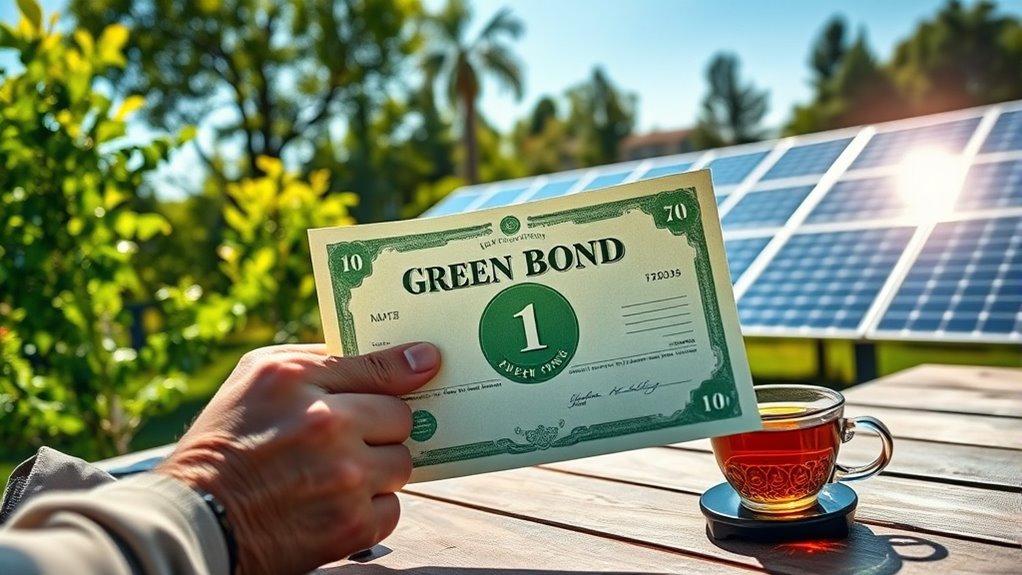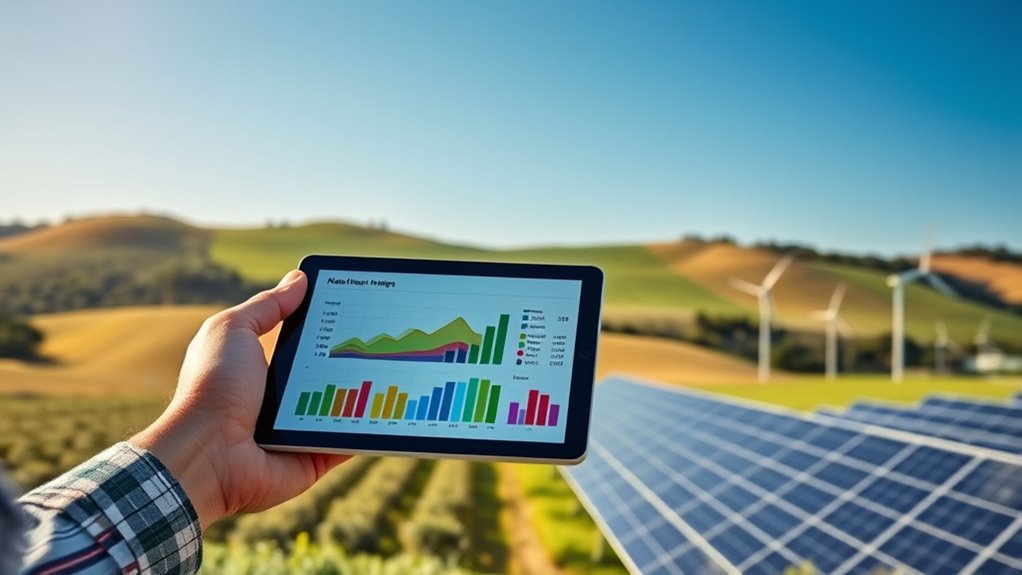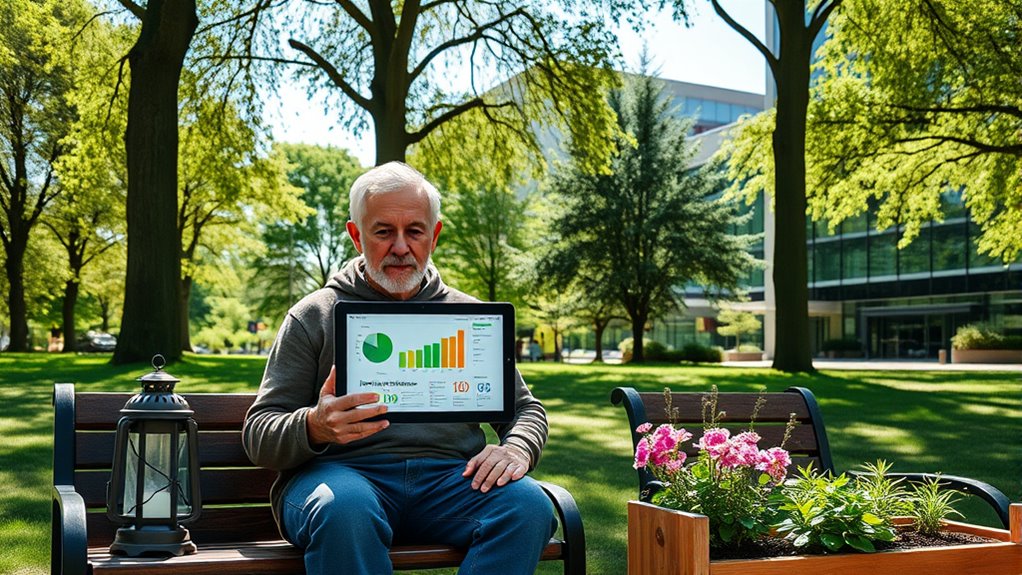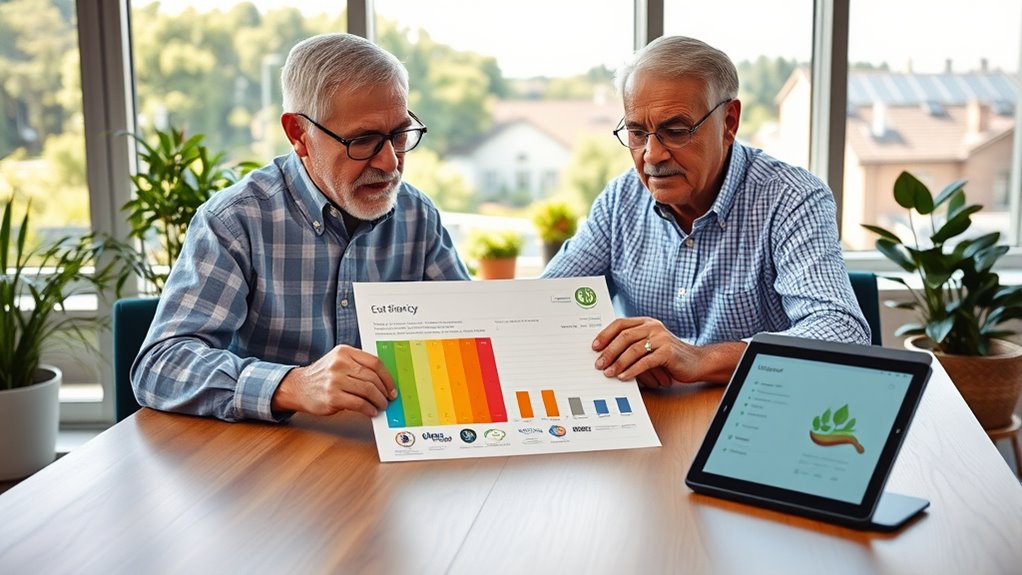Sustainable investing offers retirees options like green bonds, which support eco-friendly projects, and socially responsible mutual funds that avoid harmful companies. You can also consider impact investing platforms, renewable energy stocks, or community-focused initiatives like CDFIs. Green retirement accounts and ESG-rated funds help align your savings with your values. If you want to explore each option and how they can fit into your goals, there’s more to discover below.
Key Takeaways
- Green bonds and fixed-income investments support environmentally beneficial projects while offering stable income aligned with sustainability goals.
- Investing in renewable energy stocks and funds promotes clean energy development with potential for steady returns.
- Green retirement accounts and savings plans enable responsible growth through eco-friendly funds and tax incentives.
- Impact investing platforms and strategies help retirees fund projects with measurable social and environmental benefits.
- Evaluating sustainability ratings and certifications ensures investments align with environmental, social, and governance principles.
Green Bonds and Fixed-Income Investments

Green bonds offer a straightforward way for retirees to invest sustainably while earning fixed income. When you choose green bonds, you support projects that focus on environmental benefits, such as renewable energy or pollution reduction. These bonds are often tied to strong corporate governance practices, ensuring transparency and accountability in how funds are managed. Additionally, issuers of green bonds tend to prioritize climate risk mitigation, making them a resilient option amid changing environmental conditions. By investing in green bonds, you not only generate steady income but also contribute to combating climate change and promoting responsible corporate behavior. This approach aligns your financial goals with your environmental values, making it an appealing choice for retirees seeking sustainable, low-risk investments.
Socially Responsible Mutual Funds and ETFs

Socially responsible mutual funds and ETFs offer retirees a practical way to align their investments with their values while seeking growth and income. These funds focus on companies with strong corporate governance and a commitment to social responsibility, ensuring that your money supports ethical practices. By choosing these options, you can avoid firms involved in environmental harm, labor violations, or unethical conduct. Many funds screen companies based on their social impact, promoting transparency and accountability. As a result, you’re investing in businesses that prioritize sustainable practices and ethical standards. This approach not only helps you meet your financial goals but also allows you to contribute to positive social change. Socially responsible mutual funds and ETFs make it easier to integrate your values into your retirement portfolio.
Impact Investing Platforms and Strategies

Impact investing platforms vary in how they connect you with projects making a difference, from crowdfunding sites to specialized funds. They often use evaluation metrics like social impact scores or environmental outcomes to measure success. As a retiree, you’ll want strategies that balance financial returns with meaningful social or environmental impact.
Types of Impact Platforms
Have you ever wondered how impact investing platforms help retirees align their investments with their values? These platforms offer various types, from robo-advisors to dedicated impact funds, making it easier to find options that match your goals. They focus on impact measurement to track how investments create social or environmental benefits, ensuring transparency. Platform accessibility is key, as many now provide user-friendly interfaces suitable for retirees, with educational resources and personalized advice. Some platforms specialize in specific sectors like renewable energy or affordable housing, while others offer diversified impact portfolios. By choosing the right type of impact platform, you can confidently invest in projects that resonate with your values and contribute to positive change.
Evaluation Metrics Used
When choosing impact investing platforms, understanding how they measure success helps you make informed decisions. Common metrics include environmental and social impact indicators like carbon footprint reduction and ethical sourcing practices. These metrics reveal whether investments genuinely support sustainability goals. To compare platforms effectively, consider this table:
| Metric | Description |
|---|---|
| Carbon Footprint | Measures emissions saved or avoided through investments |
| Ethical Sourcing | Assesses supply chain transparency and fair practices |
| Social Impact Score | Quantifies community or stakeholder benefits |
| Environmental Impact | Evaluates broader ecological effects |
| Financial Return | Ensures sustainability doesn’t compromise returns |
Evaluating these metrics helps you align investments with your values while understanding their real-world impact.
Strategies for Retirees
For retirees looking to align their investments with their values, selecting the right impact investing platforms and strategies is essential. Focus on platforms that prioritize transparency and clear impact metrics to enhance your retirement planning. Diversify your portfolio to manage risk effectively, balancing traditional assets with sustainable investments. Consider strategies like impact bonds or ESG funds that target social and environmental goals while providing financial returns. Regularly review your investments to ensure they meet your risk management preferences and align with your evolving values. By choosing platforms and strategies carefully, you can support causes you care about without compromising your financial security. This approach helps you achieve a meaningful retirement while staying true to your principles.
Renewable Energy Stocks and Funds

Renewable energy stocks and funds have become an increasingly attractive option for retirees seeking sustainable investments. By investing in companies that manufacture solar panels or operate wind turbines, you support clean energy development while aiming for steady returns. Solar panel manufacturers often benefit from increasing demand as more homes and businesses adopt solar solutions, making them a resilient choice. Wind turbine companies, involved in large-scale energy projects, offer exposure to the expanding wind energy sector. Funds focused on renewable energy diversify your portfolio, reducing risk while aligning with eco-conscious goals. As the world shifts toward sustainable sources, these investments can provide both financial growth and the satisfaction of contributing to a greener future.
Community Development Financial Institutions (CDFIs)

Community Development Financial Institutions (CDFIs) allow you to support local economies while making impact investments that align with your values. By investing in CDFIs, you help promote social equity and improve access to financial services in underserved communities. These institutions offer a meaningful way to combine your retirement goals with positive social change.
Supporting Local Economies
Supporting local economies through investments in Community Development Financial Institutions (CDFIs) offers a practical way to align your retirement portfolio with your values. By investing in CDFIs, you help fund small businesses and local artisans that sustain community vitality. These institutions prioritize lending to entrepreneurs who might struggle to access traditional banking services, fostering job creation and economic resilience. Your investment supports small businesses that produce locally made goods, boosting regional economies and preserving cultural heritage. This approach guarantees your retirement savings contribute directly to communities where you live or care about. It’s a meaningful way to promote sustainable growth, strengthen local markets, and make a positive impact while pursuing your financial goals.
Accessing Impact Investments
Investing in Community Development Financial Institutions (CDFIs) provides a straightforward way to access impact investments that align with your values. CDFIs focus on ethical banking, supporting underserved communities, and promoting sustainability. Here are four ways you can get involved:
- Choose CDFI-certified funds that target local projects and social initiatives.
- Support CDFI-backed loans for small businesses, fostering community growth.
- Invest in green projects like renewable energy or carbon offsets through CDFIs.
- Participate in online platforms offering direct CDFI investments suited for retirees.
Promoting Social Equity
Have you considered how your investments can advance social equity? Investing in Community Development Financial Institutions (CDFIs) is an effective way to do this. CDFIs focus on supporting underserved communities by providing affordable loans and financial services. When choosing investments, look for those that prioritize strong corporate governance and ethical labor practices. These institutions emphasize transparency, accountability, and fair treatment of employees, which helps foster social equity. Your investment can promote equitable economic growth and improve community well-being. Supporting CDFIs aligns your retirement goals with social impact, empowering communities and reducing disparities. By selecting impact investments that prioritize social responsibility, you actively contribute to a fairer, more inclusive economy.
Sustainable Real Estate Investment Opportunities

Sustainable real estate offers retirees a compelling way to grow their wealth while making a positive environmental impact. By investing in eco-friendly architecture and urban renewal projects, you support communities and reduce your carbon footprint. Here are four key opportunities:
- Urban Renewal Projects: Revitalize neglected neighborhoods, increasing property values and community vibrancy.
- Green Building Developments: Invest in properties with eco-friendly architecture that reduce energy use and lower costs.
- Renewable Energy Integration: Support properties incorporating solar or wind power, ensuring long-term sustainability.
- LEED-Certified Properties: Focus on buildings with Leadership in Energy and Environmental Design certification for healthier living spaces.
These options allow you to align your retirement goals with environmental responsibility, creating lasting value.
ESG-Compliant Dividend Stocks

For retirees seeking steady income alongside positive environmental and social impact, ESG-compliant dividend stocks offer an attractive option. These stocks often come from companies committed to sustainability, such as those producing solar panels or developing electric vehicle technology. By investing in such companies, you support innovations that reduce carbon footprints and promote cleaner energy, while earning regular dividends. Many ESG stocks prioritize responsible sourcing, waste reduction, and community engagement, aligning with your values. You can enjoy consistent income without sacrificing your commitment to sustainability. With careful selection, these stocks help you build a resilient portfolio that reflects your desire for both financial stability and environmental stewardship. ESG-compliant dividend stocks enable you to grow your retirement savings responsibly.
Green Retirement Accounts and Savings Plans

Green retirement accounts and savings plans provide you with a practical way to align your financial goals with your commitment to environmental responsibility. By choosing green savings options, you can effectively incorporate sustainability into your retirement planning. Here are four key benefits:
- Access to eco-friendly funds that prioritize renewable energy, conservation, and sustainable companies.
- Potential for growth through investments that support green innovation and clean technology.
- Lower environmental impact by avoiding fossil fuel industries and harmful practices.
- Tax advantages and incentives designed to encourage green savings and sustainable investing.
These options empower you to grow your retirement nest egg responsibly while promoting positive environmental change. Green retirement accounts make it easier to combine financial security with your sustainability values.
Evaluating Sustainability Ratings and Certifications

When choosing green retirement accounts and savings plans, it’s important to assess how funds align with your sustainability values. Start by examining sustainability ratings and certifications, which provide insights into a fund’s commitment to environmental and social principles. Look for indicators that evaluate corporate governance, such as transparency and ethical practices, and see if the fund emphasizes stakeholder engagement. These factors show whether a company actively involves its stakeholders and maintains responsible governance, key aspects of sustainability. Certifications from reputable organizations can validate a fund’s claims and guarantee it meets rigorous standards. By carefully reviewing these ratings and certifications, you can better ensure your investments support companies that prioritize sustainability, responsible governance, and meaningful stakeholder involvement.
Frequently Asked Questions
How Do I Measure the Actual Environmental Impact of My Investments?
You can measure the environmental impact of your investments by examining impact metrics provided by fund managers or ESG reports. Look for data on their carbon footprint, which shows greenhouse gas emissions, and other impact metrics like water use or waste reduction. These indicators help you assess how your investments contribute to sustainability goals. Regularly review these metrics to guarantee your investments align with your environmental values and make informed adjustments.
Are Sustainable Investments More Profitable Than Traditional Options Long-Term?
Sustainable investments can be more profitable long-term, especially when you focus on options like green bonds and social impact funds. These investments often benefit from growing demand, regulatory support, and innovative technologies, leading to competitive returns. While they may carry some risks, they also align with your values and contribute positively to society, making them a potentially rewarding choice for your retirement portfolio.
What Are the Risks Associated With Impact Investing for Retirees?
Are you aware of the risks impact investing brings? You might face challenges with impact measurement, making it hard to gauge true social or environmental benefits. Ethical screening could limit your choices, potentially reducing diversification. Plus, market fluctuations may affect investments focused on specific causes. So, while impact investing aligns with your values, stay cautious and thoroughly research to balance ethical goals with financial stability.
How Can I Ensure My Investments Align With My Ethical Values?
To guarantee your investments align with your ethical values, you should use ESG criteria and ethical screening. Start by researching funds or companies that prioritize environmental, social, and governance factors that match your beliefs. Regularly review your portfolio to ensure it stays aligned. You may also consult with a financial advisor experienced in sustainable investing to help you select options that reflect your ethics while aiming for solid returns.
What Tax Benefits Are Available for Sustainable Investing in Retirement Accounts?
You might think sustainable investing offers no specific tax benefits, but in reality, tax incentives can boost your returns. Contributing to retirement accounts like IRAs or 401(k)s offers tax advantages, and investing in ESG funds can enhance portfolio diversification while potentially qualifying for tax credits. These benefits help you grow your savings efficiently, aligning your ethical values with financial planning, and making sustainable investing a smart, tax-efficient choice for your retirement future.
Conclusion
Think of your retirement journey as steering a ship through vibrant, sustainable waters. By choosing green bonds, socially responsible funds, and renewable energy stocks, you’re setting a course that nurtures both your future and the planet. Just like a skilled captain, you can navigate with confidence by evaluating sustainability ratings and certifications. With mindful investments, you become the hero of your financial story—sailing toward a greener, more responsible horizon.









